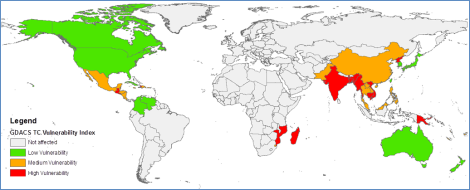 In at least one respect, climate math just got simple. A 1 degree Celsius increase in temperature yields 10 percent heavier rainfall extremes in the tropics. I mean, it’s algebra. Where t is temperature and r is rainfall extreme:
In at least one respect, climate math just got simple. A 1 degree Celsius increase in temperature yields 10 percent heavier rainfall extremes in the tropics. I mean, it’s algebra. Where t is temperature and r is rainfall extreme:
t + 1 = r x 1.1
Secure · Tax deductible · Takes 45 SecondsSecure · Tax deductible · Takes 45 Seconds
There you go. Oh, we should probably note, this is bad news for the tropics. From MIT’s description of its study that produced this formula:
Extreme precipitation in the tropics comes in many forms: thunderstorm complexes, flood-inducing monsoons and wide-sweeping cyclones like the recent Hurricane Isaac.
Global warming is expected to intensify extreme precipitation, but the rate at which it does so in the tropics has remained unclear. Now an MIT study has given an estimate based on model simulations and observations: With every 1 degree Celsius rise in temperature, the study finds, tropical regions will see 10 percent heavier rainfall extremes, with possible impacts for flooding in populous regions. …
[MIT assistant professor of atmospheric science Paul] O’Gorman found that, compared to other regions of the world, extreme rainfall in the tropics responds differently to climate change. “It seems rainfall extremes in tropical regions are more sensitive to global warming,” O’Gorman says. “We have yet to understand the mechanism for this higher sensitivity.”
The map below shows the vulnerability of various regions of the world to tropical cyclones. It takes into account various factors, including population.
Areas in the tropics — particularly south and southeast Asia — are already areas at high risk from existing climate extremes. Crank the strength of a storm up by an additional 10 percent? Much worse.
And that 10 percent is only assuming a 1 degree temperature increase. Some estimates suggest that the actual increase could be as much as 6 degrees C — meaning an increase in rainfall extremes in the tropics of 77 percent (since it’s cumulative).
Math isn’t always hard. Nor is it always reassuring.





